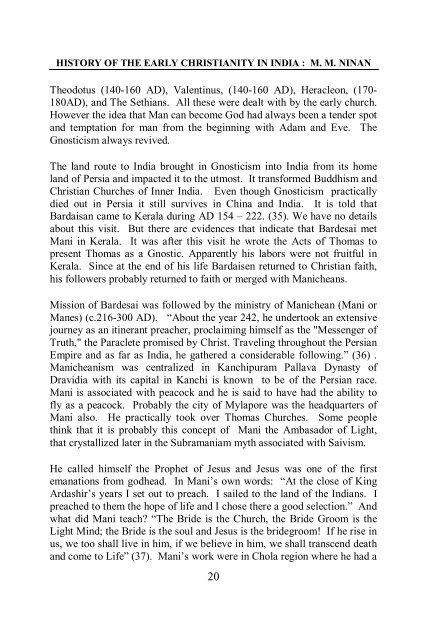History of Early Christianity in India
Create successful ePaper yourself
Turn your PDF publications into a flip-book with our unique Google optimized e-Paper software.
HISTORY OF THE EARLY CHRISTIANITY IN INDIA : M. M. NINAN<br />
Theodotus (140-160 AD), Valent<strong>in</strong>us, (140-160 AD), Heracleon, (170-<br />
180AD), and The Sethians. All these were dealt with by the early church.<br />
However the idea that Man can become God had always been a tender spot<br />
and temptation for man from the beg<strong>in</strong>n<strong>in</strong>g with Adam and Eve. The<br />
Gnosticism always revived.<br />
The land route to <strong>India</strong> brought <strong>in</strong> Gnosticism <strong>in</strong>to <strong>India</strong> from its home<br />
land <strong>of</strong> Persia and impacted it to the utmost. It transformed Buddhism and<br />
Christian Churches <strong>of</strong> Inner <strong>India</strong>. Even though Gnosticism practically<br />
died out <strong>in</strong> Persia it still survives <strong>in</strong> Ch<strong>in</strong>a and <strong>India</strong>. It is told that<br />
Bardaisan came to Kerala dur<strong>in</strong>g AD 154 – 222. (35). We have no details<br />
about this visit. But there are evidences that <strong>in</strong>dicate that Bardesai met<br />
Mani <strong>in</strong> Kerala. It was after this visit he wrote the Acts <strong>of</strong> Thomas to<br />
present Thomas as a Gnostic. Apparently his labors were not fruitful <strong>in</strong><br />
Kerala. S<strong>in</strong>ce at the end <strong>of</strong> his life Bardaisen returned to Christian faith,<br />
his followers probably returned to faith or merged with Manicheans.<br />
Mission <strong>of</strong> Bardesai was followed by the m<strong>in</strong>istry <strong>of</strong> Manichean (Mani or<br />
Manes) (c.216-300 AD). “About the year 242, he undertook an extensive<br />
journey as an it<strong>in</strong>erant preacher, proclaim<strong>in</strong>g himself as the "Messenger <strong>of</strong><br />
Truth," the Paraclete promised by Christ. Travel<strong>in</strong>g throughout the Persian<br />
Empire and as far as <strong>India</strong>, he gathered a considerable follow<strong>in</strong>g.” (36) .<br />
Manicheanism was centralized <strong>in</strong> Kanchipuram Pallava Dynasty <strong>of</strong><br />
Dravidia with its capital <strong>in</strong> Kanchi is known to be <strong>of</strong> the Persian race.<br />
Mani is associated with peacock and he is said to have had the ability to<br />
fly as a peacock. Probably the city <strong>of</strong> Mylapore was the headquarters <strong>of</strong><br />
Mani also. He practically took over Thomas Churches. Some people<br />
th<strong>in</strong>k that it is probably this concept <strong>of</strong> Mani the Ambasador <strong>of</strong> Light,<br />
that crystallized later <strong>in</strong> the Subramaniam myth associated with Saivism.<br />
He called himself the Prophet <strong>of</strong> Jesus and Jesus was one <strong>of</strong> the first<br />
emanations from godhead. In Mani’s own words: “At the close <strong>of</strong> K<strong>in</strong>g<br />
Ardashir’s years I set out to preach. I sailed to the land <strong>of</strong> the <strong>India</strong>ns. I<br />
preached to them the hope <strong>of</strong> life and I chose there a good selection.” And<br />
what did Mani teach? “The Bride is the Church, the Bride Groom is the<br />
Light M<strong>in</strong>d; the Bride is the soul and Jesus is the bridegroom! If he rise <strong>in</strong><br />
us, we too shall live <strong>in</strong> him, if we believe <strong>in</strong> him, we shall transcend death<br />
and come to Life” (37). Mani’s work were <strong>in</strong> Chola region where he had a<br />
20


















